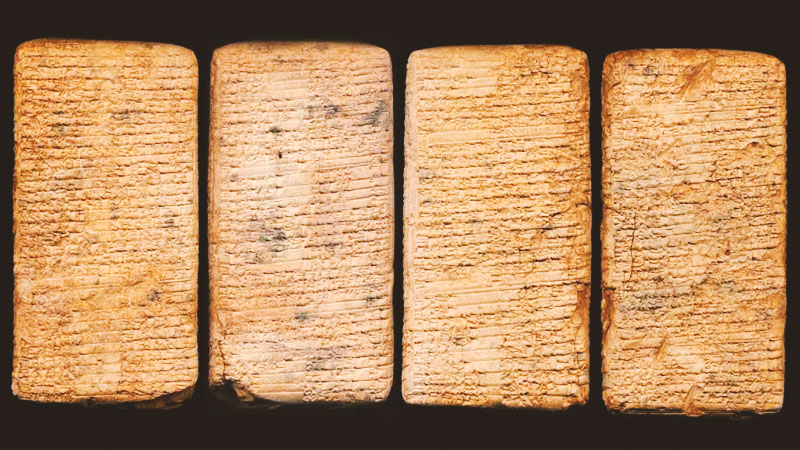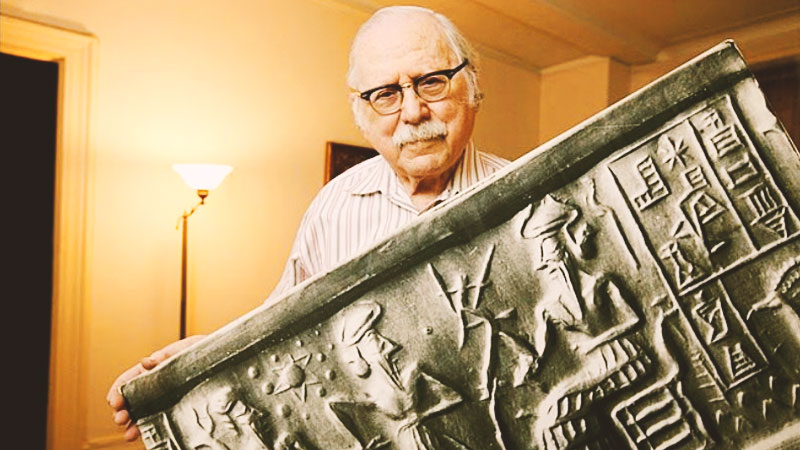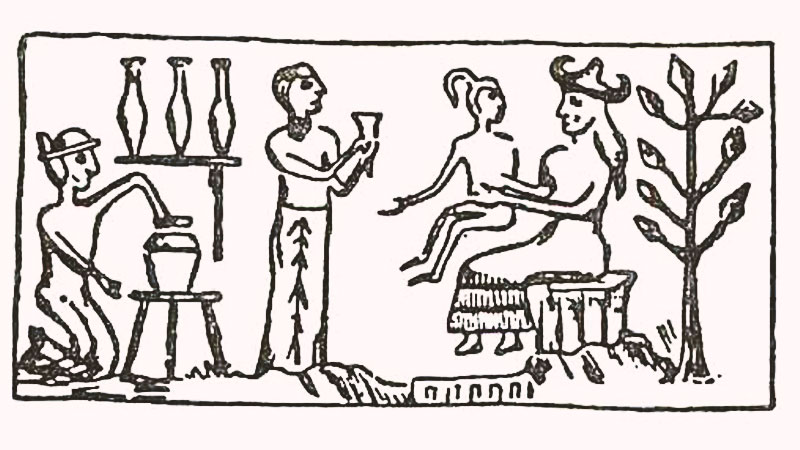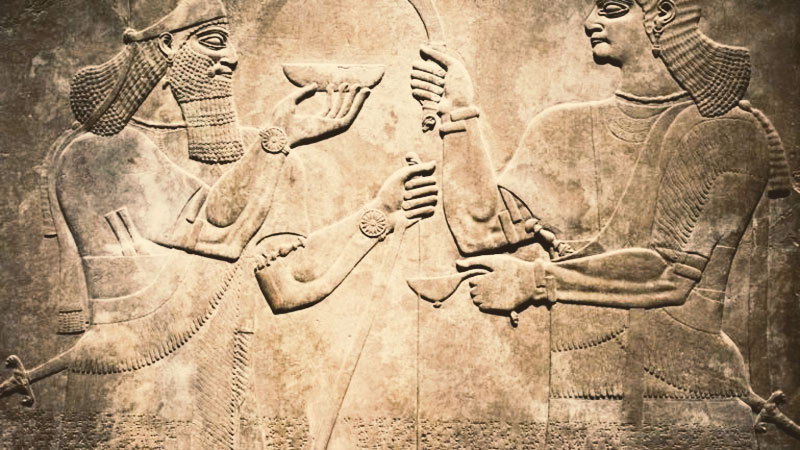The Anunnakis, or “those who came down from heaven,” were the main gods of the ancient Sumeans, Acadians, Assyrians, and Babylonians who inhabited Mesopotamia, the region in which Iran and Iraq are now located.
In Sumean mythology, Enki was one of the most important gods and the patron of the city of Eridu, considered by the ancient inhabitants of Mesopotamia as the first city built in the world.
In the Epic of Atrahasis, the epic poem of Sumerian mythology that tells the story from creation to the Great Flood, Enki is responsible for the creation of mankind, which was destined to serve the gods.
Humans, who at this time had long lives, multiplied rapidly and Enlil, the head of the gods, was very disturbed by the noise humans made and decided to send catastrophes to Earth to shrink the population, and in each catastrophe, humans begged Enki to teach them what to do to survive.

Enlil then decides to send a great flood to exterminate mankind once and for all, and as Enki was unable to thwart Enlil’s plans, he came down to Earth to save Atrahasis, whom he considered a righteous man.
Enki ordered and instructed Atrahasis to build an ark to save himself from Enlil’s wrath, and all other human beings were destroyed in the flood.
After the flood, Enlil suggested creating the human being again, but this time with some limitations, such as being less fertile, short-lived and more vulnerable than the previous race.
The Planet Nibiru
The Azerbaijani writer Zecharia Sitchin has a very different interpretation of the origin of mankind, as he exhibited in his collection of his books “The Chronicles of the Earth”.
Zecharia Sitchin described the Anunnakis as ancient astronauts and that “those who came from heaven” would be an extraterrestrial race of intellectually superior beings who taught the Sumerians about astronomy, architecture, mathematics, medicine, metallurgy and gave them written language.
Sitchin believed that the current Homo Sapiens was the result of genetic manipulation and that the Anunnakis created the Sumeans by mixing the DNA of a hominid with theirs.
Based on the Babylonian poem Enuma Elish, collected on clay tablets with cuneiform writings from the library of the Assyrian king Assurbanipal in the city of Nineveh, Zecharia Sitchin, an expert in ancient languages, begins a reinterpretation of the myth of earth’s creation, which has curious similarities to biblical Genesis.

According to his interpretation, the “Twelfth Planet” known as Nibiru, has a long elliptical orbit of 3,600 years around the Sun and was populated by beings very similar to humans.
According to Sitchin, millions of years ago, one of the two moons on the planet Nibiru would have collided catastrophically with Tiamat, an ancient planet located between Mars and Jupiter, which broke in two, and one of these halves would have been pushed into a new orbit next to one of Tiamat’s moons, forming the current planet Earth with its Moon.
Later, in another passage, the planet Nibiru itself reportedly hit the remaining fragment of Tiamat, which shattered and formed the Asteroid Belt.
After the severe collapse and in order to solve the problems suffered on their planet, the Nibiruanos began to travel through the Solar System in search of gold and, about 450,000 years ago, Nibiru approached the earth’s orbit, allowing some individuals to be sent in spacecraft to our planet.
They established their bases in ancient Mesopotamia and found important gold deposits in Southern Africa, where they established their mines to extract the valuable mineral. However, the Nibiruan masters did not perform the mining work and, for this, they sent the Anunnaki people to do this task.
The Anunnakis were beings over three meters tall, white-skinned, long-haired and bearded and on Earth, and despite their physical and intellectual abilities, began to be treated as a kind of slave, for this reason the Anunnakis soon rebelled against their supervisors and demanded the creation of an inferior being to take their place.
The Nibiruans accepted the proposal and decided to create a new species, combining their genes with the genes of the more evolved primates that lived on Earth, probably Australopithecus.

The Creation of Humanity
At first, Enki and Ninmah, who were the chief scientists, projected formidable and large-sized beings who worked for the Anunnakis in the mines, however, these new beings could not reproduce, so they had to be created continuously to achieve optimal production of mineral extractions.
Enki and Ninmah developed several prototypes of beings until they achieved one that could reproduce among themselves, so the first human species had been created in the form of Homo Erectus.
Each time Nibiru moved away from Earth, a portion of the “gods” returned to their home planet until the end of the 3,600-year cycle, a period that the Sumeans called Sar, while a portion of the Anunnakis remained on Earth to manage the gold mines and their new workers.
However, the new humans drawn in the image and likeness of their creators began to have disputes over earthly issues, forming alliances and rebelling against their masters, just as had happened before with the Anunnakis.
Many of them managed to escape the mines and settled as free individuals elsewhere on Earth to begin a new, but primitive, way of life.
After 3,600 years, the orbital cycle was once again completed, Nibiru approached our planet again and the leaders of the Anunnakis returned to Earth, only to verify that the situation was out of control again.
They punished the Anunnakis by making them work in the mines again, and during their brief visit to Earth, they began new experiments to create a new, more perfect breed of workers.
Thus, chief scientist Enki and physician Ninti made use of genetic manipulation and in vitro fertilization and designed a new species with greater intellectual capacity, capable of thinking, speaking and reproducing, thus creating Homo Sapiens.
“Man and woman created them; and he blessed them, and called them by the name of Adam, the day they were created.” Genesis 5:2

The Hebrew term Adam, therefore, does not refer to a single man, but rather to the first group of human beings called Adamites or “those who are from the earth.”
Sitchin states that ancient inscriptions report that the human civilization of Sumeria was established under the guidance of these “gods”, and the human monarchy was installed in order to provide intermediaries between humanity and the Annunakis.
However, there was still a major problem after man’s creation: the other humanoide beings that escaped and dispersed were growing and multiplying across much of the planet.
The solution came in the form of a major flood as a result of the disturbances that had been occurring in the Solar System for about 12,000 years.
The Anunnakis then decided to abandon the planet and let the flood take care of all its inhabitants, but Enki, convinced that his last creation was very perfect and unique, decided to help and save humans by instructing Atrahasis to build a gigantic ark, in a story very similar to that of biblical Noah.

According to Zecharia Sitchin, nibiru’s last pass was in 556 BC and, considering its 3,600-year orbit, its return is foreseen for the Third Millennium. However, he believes that the Anunnakis will be able to return earlier, and that the moment of return will coincide with the astrological shift from the Age of Fish to Aquarius Age, sometime between 2090 and 2370.

















